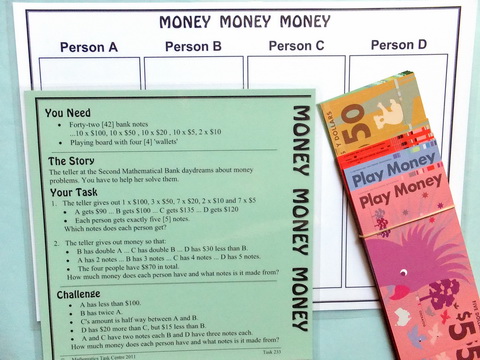
Money Money MoneyTask 233 ... Years 4 - 10SummaryThis delightful task captures attention by inviting us to daydream about, and handle, large amounts of money. Then it offers a set of challenges of increasing difficulty which are based around reasoning and problem solving strategies supported by arithmetic practice, algebraic representation and simultaneous equations. |
Materials
Content
|

IcebergA task is the tip of a learning iceberg. There is always more to a task than is recorded on the card. |
Question 1 offers an introduction which only requires logical thought. For example, one aspect of this is:
B = 2A ... C = 2B ... D = B - 30With these facts in mind, and the total of all monies being $870, a key clue is that A has only two notes. The choices for those two are limited so one approach is to build a table exploring all possibilities:
The table also allows students to workout the notes each person has:
|
|||||||||||||||||||||
Whole Class InvestigationTasks are an invitation for two students to work like a mathematician. Tasks can also be modified to become whole class investigations which model how a mathematician works. |
Handling the money in this task - putting it in and out of the wallets to try different possibilities - is critical to the thinking (and involvement) of many students. So, to turn this task into a whole class investigation requires a lot of 'money'. However, this need not be play money as in the task. In the whole class setting students can work in groups of 4, so it will only be each table that needs the 42 notes. A little time at a guillotine cutting A4 paper into fifths across its width will soon produce bundles of 42 for each table. That's 10 for each person to prepare (and a couple of extras for the first finished to complete). Preparing is simply writing the 'currency value' as large as possible on each note using a marker. You can also easily prepare and duplicate a set of 'wallets' for each table. Or the students can make their own from A4 paper by folding. The lesson begins with something like: I have some money challenges for you today that I hope you will find interesting. I think they were created by a bank teller who didn't have many customers. But first we have to make our own money...The focus of the lesson is to use the three problems to generate discussion, share reasoning insights and convince each other of the answers. Once begun the lesson will gather its own flow and groups will not be working on the same problem at the same time. So consider dividing your board into three sections and, as you find groups with 'something to say', encouraging them to record key points on the board. This will support other groups and provide the basis for later discussion about identifying key information in a word problem. It can also be the basis of student reporting of the problems. The next lesson begins with a question like: Where do you think our bored bank teller from yesterday started when she created her three problems? ... Do you think she just copied them from a book?Agree that she probably started by putting notes into piles, a regular part of a teller's work, and then - as one student put it - looked at the piles with new eyes. Set each group the task of creating their own problem with the money from the previous lesson. It is a significant reasoning exercise to design and test such problems. Perhaps those which pass the test of their peers could appear on the school web site or receive recognition in some other way. Note: Another way to use this task is to introduce the first problem (or the second, depending on the age and experience of your students) as a Poster Problem Clinic.At this stage, Money Money Money does not have a matching lesson on Maths300. |
Is it in Maths With Attitude?Maths With Attitude is a set of hands-on learning kits available from Years 3-10 which structure the use of tasks and whole class investigations into a week by week planner. |
The Money Money Money task is an integral part of:
|